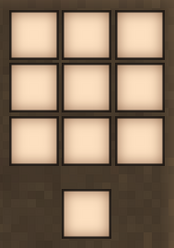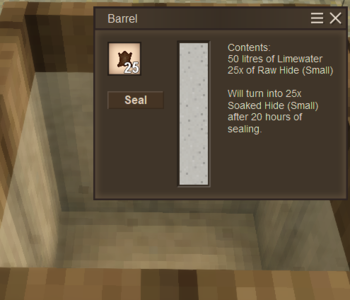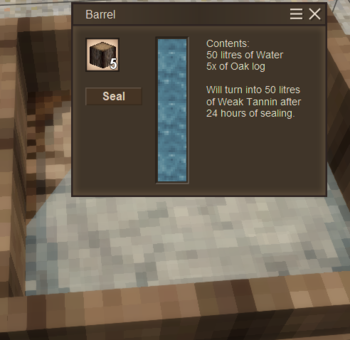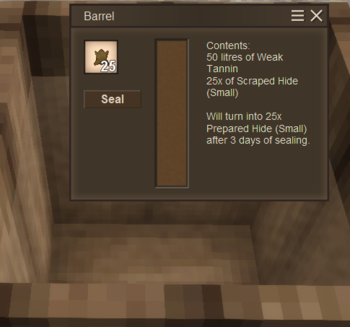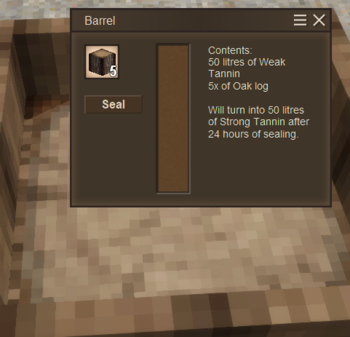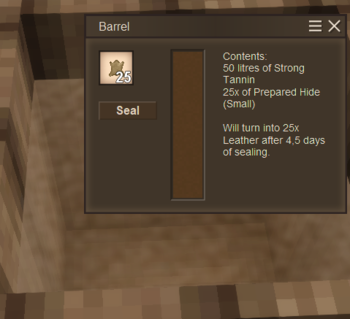Leather working
Leather working is a specialized series of barrel recipes that players can use to convert raw hides into leather.
Required materials
To create leather, a player needs:
- A supply of lime or powdered borax.
- A supply of oak or acacia logs to make tannin.
- A bucket or clay bowl to transfer liquid. A bucket holds 10 liters of liquid. A bowl holds 1 liter.
- Barrels to process hides. A barrel holds 50 liters (or 5 buckets) of liquid.
- Raw hides.
- A knife.
- A hammer or quern.
Hides
Hides can be looted from wild or domesticated animals upon death.
A barrel containing a full 50L of solution can process up to:
- 25 small hides (2L per hide and will use all of the solution)
- 12 medium hides (4L per hide and will have 2L left over)
- 8 large hides (6L per hide and will have 2L left over)
- 5 huge hides (10L per hide and will use all of the solution)
Lime & Powdered Borax
Lime can be extracted from loose limestone, loose chalk stone, or sea shells. Limestone and chalk may be either crushed with a hammer in your inventory crafting grid, or ground in a quern. Both methods yield the same amount of lime per loose stone; however, using a hammer will consume some of the tool's durability, while a quern does not get damaged by repeated use. One loose stone yields one lime.
One shell yields two lime. Shells cannot be crushed with a hammer and must be ground in a quern.
Lime can also be used to make quicklime, which is necessary to produce plaster and mortar.
Powdered borax is an alternative to lime that can be extracted by grinding a chunk of borax ore in a quern. One borax chunk yields two powdered borax.
Powdered borax is also a necessary material in the process of smithing an iron or meteoric iron anvil.
| Ingredients | Crafting Recipe |
|---|---|
| 1x Hammer 3x Chalk stone |
Example Shopping List
To process 8 leather, which would be sufficient to craft 1 leather backpack, the player would need the following materials (rounded up in parentheses):
- Oak or Acacia Logs: 3 for small hides or 6 for medium, large or huge hides
- Lime or Powdered Borax - one lime or chalk stone can be ground into one lime; one borax can be ground into two powdered borax
- Lime: 8 for small, 17 (20) for medium, 19 (20) L for large and 20 L for huge
- Powdered borax: 4 for small or 8 for medium, large or huge
- Hides: either 8 small, 4 medium, 3 large or 2 huge
- Limewater or Diluted Borax: 8 (10) L for small, 17 (20) L for medium, 19 (20) L for large and 20 L for huge
- Weak Tannin: 16 (20) L for small, 34 (40) L for medium, 38 (40) L for large and 40 L for huge - of which half will be turned into:
- Strong tannin: 8 (10) L for small, 17 (20) L for medium, 19 (20) L for large and 20 L for huge
Hide Processing Sequence
Players may only process one size of hide at a time: small, medium, large, or huge. Also, each of the sizes use different amounts of solution. One huge, large, medium or small hide require 10, 6, 4, or 2 liters respectively.
The different sizes of hides also give different amounts of leather after finished processing. One huge, large, medium, and small hide produce 5, 3, 2, and 1 leather respectively.
The following chart shows the requirements to make one full barrel of each solution, as used farther down in the respective processing steps:
| Base Liquid | Solute | Makes 1 Full Barrel of |
|---|---|---|
| 50 L Water | 50 Lime | Limewater |
| 50 L Water | 20 powdered borax | Diluted Borax |
| 50 L Water | 5 oak/acacia logs | Weak Tannin |
| 50 L Weak Tannin | 5 oak/acacia logs | Strong Tannin |
Step 1: Limewater or Diluted Borax
To make soaked hides, limewater or diluted borax may be used:
- Limewater: 1 liter of water and 1 lime makes 1 liter of limewater - which means a full barrel of limewater requires 50 lime.
- Diluted borax: 5 liters of water and 2 powdered borax make 5 liters of diluted borax - which means a full barrel of diluted borax requires 20 powdered borax.
To make either limewater or diluted borax, it is not required to seal the barrel or wait for a processing time. Simply add the required amount of lime or powdered borax to a barrel filled with the required amount of water; if the ratio is correct, the water will instantly change into limewater or diluted borax. If the player is unsure about the correct ratio, simply fill the barrel with the amount of water and keep adding lime or powdered borax one by one until the change happens.
Once the player has acquired the necessary lime or borax solution, the raw hides can be placed inside the barrel, after which it needs to be sealed for 20 in-game hours to turn into soaked hides. Similar to the above process, a specific ratio must be reached. The player can start with one hide and check the barrel tooltip; it should display the amount of liquid solution and input hides as well as the possible output. If there is no output shown, the player placed too many hides in the barrel for the available amount of liquid.
Step 2: Scraping Hides
Once the raw hides have been soaked long enough, they will turn into soaked hides. These cannot directly be further processed in barrels; another crafting step comes in between. The player needs to put the soaked hides and a knife into the inventory crafting grid to process them into scraped hides. Please note that the knife will lose durability in the process.
| Ingredients | Crafting Recipe |
|---|---|
| 1x Knife 1x Soaked hide |
Step 3: Weak Tannin
To make weak tannin, the player needs 10 units of water per oak/acacia log. After inputting the oak log, the barrel tooltip will display the materials present as well as the predicted output. The barrel must be sealed for 24 in-game hours to actually produce weak tannin; it cannot be sealed if an unbalanced ratio of water and oak logs are present in the barrel.
After the player acquired weak tannin with the above procedure, place the scraped hides into the weak tannin solution. Again, further processing of the hides requires sealing in the barrel - after 4 in-game days they will become prepared hides. Similar to the previous processes, a specific ratio must be reached. The player can start with one hide and check the barrel tool tip; it should display the possible output. If there is no output shown, the player placed too many hides in the barrel for the available amount of liquid, and the player will not be able to seal it.
Step 4: Strong Tannin
To make strong tannin, the player needs 10 liters of weak tannin per oak/acacia log. After inputting the log, the barrel tooltip will display the materials present as well as the predicted output. The barrel must be sealed for 24 in-game hours to actually produce strong tannin; it cannot be sealed if an unbalanced ratio of water and oak logs are present in the barrel.
After the player acquired strong tannin with the above procedure, place the prepared hides into the strong tannin solution. Again, further processing of the hides requires sealing in the barrel; after another 4.5 in-game days they will become leather. Similar to the previous processes, a specific ratio must be reached. The player can start with one hide and check the barrel tooltip; it should display the possible output. If there is no output shown, the player placed too many hides in the barrel for the available amount of liquid, and the player will not be able to seal it.
After waiting for the sealed hides to process, the player will be rewarded with the respective amount of leather ready to be used in crafting.
Usage
Leather can be used in recipes for
- leather backpack which adds 6 inventory slots
- several types of armor
- a few clothing items
- sling
- books
- dyed leather
- glider
- bows
- leather reinforced wooden shield
- antler mount
For a detailed overview check the leather page.
See also
Recipes in the Handbook can't always be easily discerned. Move your mouse cursor over a hide to check whether the image represents a raw hide, or a soaked one, etc. Remove the cursor to see the recipe resume cycling through all the possible options. Be sure to prepare the correct sort of hide for the recipe you want to craft.
Pelt
Making pelts is much simpler than making leather, requiring only lumps of fat and time to cure.
Several crafting recipes use cured pelts:
- lamellar armor
- fur coat
- knee-high fur boots
- fur gloves
- fur lined reindeer herder shoes
- reindeer herder fur coat
- hunter backpack which adds 4 inventory slots
- longbow
Raw hide
A few crafting recipes use untreated hides:
History
- Icons and models for hides were changed in 1.19.4-rc.1
"Hides have new models and textures, and can be placed on the ground"
Notes
Video Tutorials
| Detailed explanation how to make leather. |
|---|
Gallery
References
| Wiki Navigation | |
|---|---|
| Vintage Story | Guides • Frequently Asked Questions • Soundtrack • Versions • Controls |
| Game systems | Crafting • Knapping • Clay forming • Smithing • Cooking • Temperature • Hunger • Mining • Temporal stability • Mechanical power • Trading • Farming • Animal husbandry |
| World | World generation • Biomes • Weather • Temporal storms |
| Items | Tools • Weapons • Armor • Clothing • Bags • Materials • Food |
| Blocks | Terrain • Plants • Decorative • Lighting • Functional • Ore |
| Entities | Hostile entities • Animals • NPCs • Players |
| Miscellaneous | List of client commands • List of server commands • Creative Starter Guide • Bot System • WorldEdit • Cinematic Camera • Adjustable FPS Video Recording • ServerBlockTicking |
